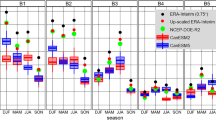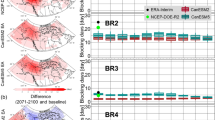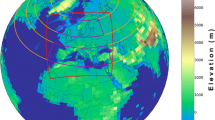Abstract
Using NCEP/NCAR reanalysis (NNR) data and 13 models from phase 5 of Coupled Model Intercomparison Project (CMIP5), this study focuses on historical statistics and future change in blocking over key regions (Urals, Baikal, and Okhotsk regions) in Eurasia. The statistical characteristic using NNR data shows that short-duration and long-duration blocking highs are 75 and 25% of the total, respectively. It is also shown that frequency of blocking highs presents a decreased trend in Eurasia during 1956–2006, except blocking highs in summer in Baikal region, long-duration blocking highs in summer, and short-duration blocking highs in winter in Okhotsk region. Compared with NNR, the frequency of blocking highs is underestimated in Eurasia by CMIP5 models, except these with long-duration in the Baikal and Okhotsk regions. Most of the CMIP5 models can reproduce the historical trend of blocking highs over Eurasia during 1956–2005. In addition, projections show that the future change of long-duration blocking highs in Eurasia is not always consistent with that in the whole Northern Hemisphere. The results of the multiple models ensemble (MME) suggest that long-duration blocking highs in the Urals will significantly increase by 0.3 times/10 years (decrease by 0.22 times/10 years) under RCP4.5 (RCP8.5) in the wintertime. In the summertime, the frequency fluctuates with little change. In Okhotsk, long-duration blocking highs will increase by 0.23 times/10 years (decrease by 0.22 times/10 years) in the wintertime (summertime) under RCP4.5. Under RCP8.5, long-duration blocking high frequency will remain the same, and the decreasing trend in the wintertime and the increasing trend (0.32 times/10 years) in the summertime will even accelerate over the trends in the twentieth century.








Similar content being viewed by others
References
Barnes EA, Hartmann DL (2010) Influence of eddy-driven jet latitude on North Atlantic jet persistence and blocking frequency in CMIP3 integrations. Geophys Res Lett 37:1–5
Barnes EA, Slingo J, Woollings T (2012) A methodology for the comparison of blocking climatologies across indices, models and climate scenarios. Clim Dyn 38:2467–2481
Barriopedro D, García-Herrera R, Trigo RM (2010) Application of blocking diagnosis methods to general circulation models. Part I: a novel detection scheme. Clim Dyn 35:1373–1391
Cheung N, Zhou W (2015a) Implications of Ural blocking for East Asian winter climate in CMIP5 GCMs. Part I: Biases in the Historical Scenario J Clim 28:2203–2216
Cheung N, Zhou W (2015b) Implications of Ural blocking for East Asian winter climate in CMIP5 GCMs. Part II: projection and uncertainty in future climate conditions. J Clim 28:2217–2233
Corti S, Giannini A, Tibaldi S et al (1997) Patterns of low-frequency variability in a three-level quasi-geostrophic model. Clim Dyn 13:883–904
Croci-Maspoli M, Schwierz C, Davies HC (2007) A multifaceted climatology of atmospheric blocking and its recent linear trend. J Clim 20:633–649
D’Andrea F, Tibaldi S, Blackburn M et al (1998) Northern Hemisphere atmospheric blocking as simulated by 15 atmospheric general circulation models in the period 1979–1988. Clim Dyn 14:385–407
de Vries H, Woolings T, Anstey J et al (2013) Atmospheric blocking and its relation to jet changes in a future climate. Clim Dyn 41:2643–2654
Ding Y, Krishnamurti TN (1987) Heat budget of the Siberian high and the winter monsoon. Mon Wea Rev 115:2428–2449
Doblas-Reyes FJ, Casado MJ, Pastor MA (2002) Sensitivity of the Northern Hemisphere blocking frequency to the detection index. Clim Dyn 107(D2):ACL 6–1–ACL 6–22
Dole R, Gordon N (1983) Persistent anomalies of the extratropical northern hemisphere wintertime circulation - geographical-distribution and regional persistence characteristics. Mon Wea Rev 111(8):1567–1586
Dunn-Sigouin E, Son S-W (2013a) Northern Hemisphere blocking frequency and duration in the CMIP5 models. J Geophys Res 118:1179–1188
Dunn-Sigouin E, Son S-W (2013b) Evaluation of Northern Hemisphere blocking climatology in the global environment multiscale model. Mon Wea Rev 141:707–727
Gong HN, Wang L, Chen W et al (2014) The climatology and interannual variability of the East Asian winter monsoon in CMIP5 models. J Clim 27(4):1659–1678
Ji MX, Huang JP, Wang SW et al (2008) Winter blocking episodes and impact on climate over East Asia. Plateau Meteorology 27(2):415–421
Kalnay E, Kanamitsu M, Kistler R et al (1996) The NCEP/NCAR 40-year reanalysis project. Bull Am Meteorol Soc 77:437–471
Li S, Ji L, Lin W et al (2001) The maintenance of the blocking over the Ural Mountains during the second Meiyu period in the summer of 1998. Adv Atmos Sci 18(1):87–105
Li W, Wang Q, Wang X (2007) The real-time operational system of monitoring and diagnostics on the Northern Hemisphere blocking high. Meteorological Monthly 33(4):77–81
Li Y, Wang S, Jin R (2012) Abnormal characteristics of blocking high during durative low temperature, snowfall and freezing weather in southern China. Plateau Meteorology 31(1):94–101
Liu Y, Wang Y, Liu J (2012) Inter-annual change of Lake Baikal blocking high and its possible relation to precipitation over China in summer. Desert and Oasis Meteorology 6(1):16–20
Lupo AR, Mokhov II, Akperov MG et al (2012) A dynamic analysis of the role of the planetary- and synoptic-scale in the summer of 2010 blocking episodes over the European part of Russia. Adv Meteorol 2012:1–11
Masato G, Hoskins BJ, Woollings T (2013) Winter and summer Northern Hemisphere blocking in CMIP5 models. J Clim 26(18):7044–7059
Matsueda M, Mizuta R, Kusunoki S (2009) Future change in the wintertime atmospheric blocking simulated using a 20-km-mesh atmospheric global circulation model. J Geophys Res 114:D12114
Mizuta R (2012) Intensification of extratropical cyclones associated with the polar jet change in the CMIP5 global warming projections. Geophys Res Lett 39:L19707
Mokhov II, Akperov MG, Prokofyeva MA et al (2013) Blockings in the Northern Hemisphere and Euro-Atlantic region: estimates of changes from reanalysis data and model simulations. Dokl Earth Sci 449(2):430–433
Mokhov II, Timazhev AV, Lupo AR (2014) Changes in atmospheric blocking characteristics within Euro-Atlantic region and Northern Hemisphere as a whole in the 21st century from model simulations using RCP anthropogenic scenarios. Glob Planet Change 122:265–270
Nakamura H, Fukamachi T (2004) Evolution and dynamics of summertime blocking over the Far East and the associated surface Okhotsk high. Quart J Roy Meteor Soc 130(599):1213–1233
Park Y-J, Ahn J-B (2014) Characteristics of atmospheric circulation over East Asia associated with summer blocking. J Geophys Res Atmos 119:726–738
Pavan V, Doblas-Reyes FJ (2000) Multi-model seasonal forecasts over the Euro-Atlantic: skill scores and dynamic features. Clim Dyn 16:611–625
Ren HL, Jin FF, Kug JS et al (2009) A kinematic mechanism for positive feedback between synoptic eddies and NAO. Geophys Res Lett 36:L11709
Rex DF (1950) Blocking action in the middle troposphere and its effect on regional climate. Tellus 2(3):196–211
Sato N, Takahashi M (2007) Dynamical processes related to the appearance of the Okhotsk high during early midsummer. JClim 20:4982–4994
Scaife AA, Woollings T, Knight J et al (2010) Atmospheric blocking and mean biases in climate models. J Clim 23(23):6143–6152
Scaife AA, Copsey D, Gordon C et al (2011) Improved Atlantic winter blocking in a climate model. Geophys Res Lett 38:L23703
Takaya K, Nakamura H (2005a) Geographical dependence of upper-level blocking formation associated with intraseasonal amplification of the Siberian High. J Atmos Sci 62(12):4441–4449
Takaya K, Nakamura H (2005b) Mechanisms of intraseasonal amplification of the cold Siberian high. J Atmos Sci 62(12):4423–4440
Taylor KE, Stouffer RJ, Meehl GA (2012) An overview of CMIP5 and the experiment design. Bull Amer Meteoro Soc 93:485–498
Tibaldi S, Molteni F (1990) On the operational predictability of blocking. Tellus A 42(3):343–365
Vial J, Osborn TJ (2012) Assessment of atmosphere-ocean general circulation model simulations of winter Northern Hemisphere atmospheric blocking. Clim Dyn 39:95–112
Wang L, Chen W, Zhou W et al (2010) Effect of the climate shift around mid 1970s on the relationship between winter Ural blocking circulation and East Asian climate. Inter J Climatol 30(1):153–158
Zhang Q, Tao S (1998) Influence of Asian mid high circulation on east Asian summer rainfall. Acta Meteorologica Sinica 56(2):199–211
Zhou W, Chan J, Chen W et al (2009) Synoptic-scale controls of persistent low temperature and icy weather over southern China in January 2008. Mon Wea Rev 137:3978–3991
Acknowledgements
We acknowledge the World Climate Research Programme’s Working Group on Coupled Modelling and thank the climate modeling groups for producing and making available model output. This work was supported by the Natural Science Foundation of China (No. 41225018, 41305105, 91644226, and 41575138), National Key R&D Program (2016YFA0602004), and Fundamental Research Funds for the Central Universities (lzujbky-2016-16). The authors are grateful to China Scholarship Council (CSC) for providing financial support and the University of Utah for providing working conditions for Dr. Yan Li during her visiting in the University of Utah.
Author information
Authors and Affiliations
Corresponding author
Rights and permissions
About this article
Cite this article
Li, Y., Ye, P., Pu, Z. et al. Historical statistics and future changes in long-duration blocking highs in key regions of Eurasia. Theor Appl Climatol 130, 1195–1207 (2017). https://doi.org/10.1007/s00704-017-2079-8
Received:
Accepted:
Published:
Issue Date:
DOI: https://doi.org/10.1007/s00704-017-2079-8




